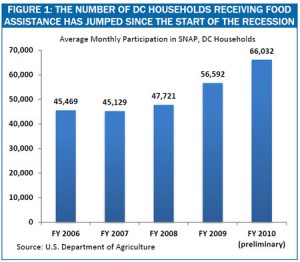Here at the District’s Dime, we’ve been reporting for the last few years on how the number of DC residents in need of help to put food on the table has jumped sharply in the recession. So we were a little surprised to see an article last week in the Examiner that said the number of DC households receiving food stamps dropped from 2009 to 2010.
Why the difference?
Well, it turns out the different accounts all come down to the source of the data, and unfortunately the Examiner did not rely on the best available data on use of food stamps (now known as SNAP, or the Supplemental Nutrition Assistance Program) . The best figures, from the program itself, confirm that food stamp participation is up sharply in DC.
The Examiner relied on a Census Bureau brief based on data from the American Community Survey (ACS). While the ACS is a great source for data on incomes, poverty status, health insurance coverage and demographic data, it is not the most authoritative source on the number of people receiving public benefits, like food stamps.
Instead, researchers typically go straight to the US Department of Agriculture, the agency that runs the program, for direct administrative data on food stamp usage. The USDA aggregates reports from state and local food stamp offices across the country for a more authoritative look at how food stamp use varied from state to state and year to year.
on food stamp usage. The USDA aggregates reports from state and local food stamp offices across the country for a more authoritative look at how food stamp use varied from state to state and year to year.
USDA figures show a 17 percent increase in the number of DC households receiving food stamps from 2009 to 2010, not a decrease. It shouldn’t be much of a surprise that the number of families in DC seeking help from the food stamp program has risen in the last few years. Both unemployment and poverty have worsened in DC over the last few years, making it harder for families to make ends meet and take care of their basic needs.
With Thanksgiving just around the corner, it is important to remember how many residents are at risk of going hungry ‘ and what an important role the food stamp program plays in fighting hunger.
